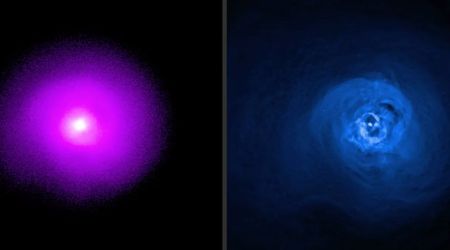NASA's Chandra telescope discovers fracture in galactic 'bone' caused by a speeding pulsar

NASA’s Chandra X-ray Observatory telescope helped astronomers find the reason for a cosmic “bone” fracture in the galaxy. It was hit by a fast-moving, rapidly spinning neutron star or pulsar, speeding at around 1 to 2 million miles per hour, according to NASA. The discovery was led by a team of astronomers from Northwestern University who studied the cosmic fracture in “the Snake” or G359.13142-0.20005 (G359.13 for short). The Snake is situated 26,000 light-years away from Earth and is a 230 light-year-long “Galactic Center Filament” in the constellation of Sagittarius.

The image of the Snake showed a break, or a fracture, along its continuous length. Moreover, the data about the fracture was gathered from the Chandra X-ray Observatory, MeerKAT radio array, and the National Science Foundation’s Very Large Array. This data revealed an X-ray and radio source at the fracture’s site, and a possible pulsar was determined. There was also an extra source of X-rays near the pulsar that could have been from high-energy electrons and positrons. The pulsar’s hit distorted the magnetic field and caused the radio signals to be warped.

“We argue that the major kink is created by a fast-moving object punching into the Snake, distorting its magnetic structure, and producing X-ray emission,” the researchers noted in their study published in the Monthly Notices of the Royal Astronomical Society. Pulsars are dense neutron stars, released from massive stars that collapsed and went supernova. This explosion gives a powerful boost that sends the pulsars soaring across space. The radio waves that are observed on Earth are from energized particles spinning along the magnetic fields.

"A secondary kink is argued to be induced by the impact of the high-velocity object producing the major kink," the researchers wrote, per Newsweek. The Snake is one of the largest and brightest of all the Galactic Center Filaments in the Milky Way. These structures are intertwined by magnetic fields that run parallel to radio wave data. The image showed the galactic center filament in blue for the X-ray and gray for the radio data. It was perpendicular to the galactic plane, and astronomers were unsure about their formation or interweaving.

As the filament had two kinks, the pulsar was found to be the culprit for the bigger one, and the impact kink remained under debate. The pulsar at the center of the deformed filament was only visible due to X-ray emissions, per Astronomy. This released image consisted of two composite images of a long, thin, cosmic structure to identify the fracture and the cause. In the first image, the filament was stretched from the top to the bottom of the frame, and a few specks were around it. A close-up showed one speck to be interacting with the structure, as per NASA.

The distortion was a small break in the filament, and astronomers believed the pulsar hit the filament halfway down its length. The Chandra program is overseen by NASA’s Marshall Space Flight Center in Huntsville, Alabama. The Chandra X-ray Center of the Smithsonian Astrophysical Observatory controls the satellite’s science operations from Cambridge and flight operations from Burlington, both in Massachusetts. The telescope, based in space, was launched by NASA in 1999, and it detects X-ray emissions from high-energy regions of the universe.









